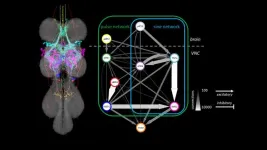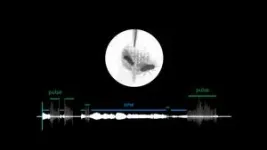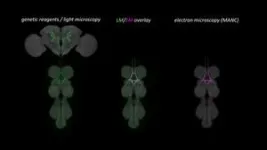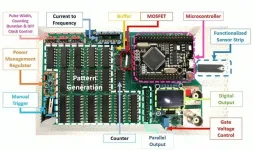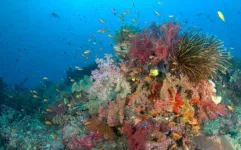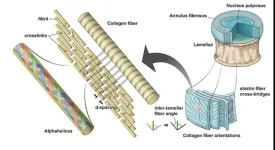(Press-News.org) Like a Valentine’s Day dinner or a box of chocolates, male fruit flies have their own rituals for wooing a potential mate.
As part of a complex courtship behavior, male flies vibrate their wings to produce a distinctive song that conveys a message to nearby females. Using internal information and cues from females and the environment, males decide moment to moment whether to sing and how.
Although scientists now know a lot about how fly movements produce songs, it was still not clear which cells and circuits in the fly’s nervous system enable the behavior.
Now, using a suite of novel tools, including a custom-built fly recording studio, researchers at HHMI's Janelia Research Campus have pinpointed the group of neurons in the nerve cord – a structure analogous to our spinal cord – that produce and pattern the fly’s two major courtship songs. They’ve also measured neuronal activity in these cells while flies were singing to understand how these neurons control each type of song.
The result is an in-depth view of how the fly nervous system coordinates a complex social behavior and generates multiple movements using a common set of muscles – information that could help researchers better understand how other animals, including humans, implement sophisticated actions.
The work also provides a new map of the neurons in the nerve cord required for fly courtship song, enabling researchers worldwide to further probe how the behavior evolved and how signals are produced.
“Combining several experimental approaches enabled us to examine the structural, physiological, and functional properties of the song circuit in order to learn how these behaviors are produced,” says Joshua Lillvis, a research scientist who led one of two projects to characterize the neural circuits. “But on top of that, I think this will be a big resource for the community that people will be mining for many years.”
Modeling behavior
The well-studied fruit fly is a key tool for neuroscientists investigating the neural underpinnings of behavior.
“It is a great model for complex motor programs and communication between the sexes and how those communications evolve,” says Janelia Senior Group Leader David Stern, a senior author on the research. “Those questions are hard to answer in any other system.”
Because flies are so actively studied, there are now many new tools available to probe these questions, including genetic tools to target specific cells and connectomes that map out the fly’s neurons and their connections.
“All the pieces are coming together now to enable a really deep understanding of how these behaviors are constructed and interpreted by the female and then how these behaviors are evolving,” Stern says.
One question, two approaches
By taking advantage of many of these new tools, researchers at Janelia set out to investigate the neurons and circuits underlying the movements that produce fly courtship song in two different, but complementary, ways.
One project, led by Lillvis, used a collection of genetically engineered flies developed at Janelia that target more than 40 different types of cells that connect to the fly’s wings and nerve cord. These fly strains allowed for systematic testing of the roles different neurons play in generating courtship songs.
The team used a custom-built fly recording studio to simultaneously record the songs generated by 96 flies. As they activated or silenced each cell type while the flies sang, the researchers could tease out the role of different neurons in generating the signal. They analyzed more than 1,800 hours of song from more than 5,000 male flies to quantify how changes in neuronal activity affected different characteristics of the two songs.
Once they identified the neurons involved, the team then used the fly ventral nerve cord connectome, completed by Janelia researchers and collaborators last year, to trace how the neurons were connected to each other.
The team found that a small number of neurons are critical for producing fly songs, and that these cells form a highly connected, overlapping circuit that generates the two main types of songs. The full circuit of neurons produces one song – the more ancestral of the two songs – while a subset of neurons in the circuit produces the second, more recently evolved, song.
“We think that this might be a common mechanism: as an animal evolves new behaviors, it takes a portion of the circuits that already exist and modifies what they do,” Lillvis says.
In a complementary project, led by Janelia Research Scientist Hiroshi Shiozaki, the researchers examined the neural activity of singing flies to understand how the neurons produce the song.
To do this, the researchers used a novel instrument Shiozaki developed in Japan and brought to Janelia in his suitcase. Using the combination recording device and microscope, the team was able to image the neural activity in the fly’s nerve cord while the insect sang – something that had not been done before. This allowed the team to home in on which neurons contributed to different aspects of behavior.
Remarkably, these two approaches converged on the same conclusion: one nested circuit controls both song types. The results also suggest there is one pathway in the brain that defines when to sing and another pathway that specifies what type of song to sing. These “when” and “what” pathways provide input to nerve cord neurons, activating different cells in the nested circuit that enable the production of the different songs.
For Shiozaki, seeing the project come to fruition is a long-term dream, one that he and Lillvis hope to build on as they further probe how fly song evolved, including in different species of fruit flies.
“It is exciting because it opens up lots of new directions to study the long-term evolution of behavior and more detailed analysis of how complex motor behaviors are produced,” Shiozaki says.
END
Why do flies fall in love? Researchers tease out the signals behind fruit fly courtship songs
2024-02-13
ELSE PRESS RELEASES FROM THIS DATE:
Polar bears unlikely to adapt to longer summers
2024-02-13
PULLMAN, Wash. – More time stranded on land means greater risk of starvation for polar bears, a new study indicates.
During three summer weeks, 20 polar bears closely observed by scientists tried different strategies to maintain energy reserves, including resting, scavenging and foraging. Yet nearly all of them lost weight rapidly: on average around 1 kilogram, or 2.2 pounds, per day.
Some have speculated that polar bears might adapt to the longer ice-free seasons due to climate warming by acting like their grizzly bear relatives ...
Gastric bypass improves long-term diabetes remission, even after weight recurrence
2024-02-13
Key takeaways
Diabetes remission: Gastric bypass surgery results in high rates of Type-2 diabetes remission five years after the operation, even after patients regain a significant amount of weight.
Gastric bypass vs. sleeve gastrectomy: Patients who underwent sleeve gastrectomy and regained their weight were five times more likely to see their diabetes return than patients who had gastric bypass surgery and regained their weight.
CHICAGO (February 13, 2024): Adults who have obesity and Type 2 diabetes are much more likely to see their diabetes stay in remission if they undergo gastric ...
Would you prefer a mammogram, MRI, or saliva on a test strip?
2024-02-13
WASHINGTON, Feb. 13, 2024 — Breast cancer is on the rise, but new tools for early detection could save lives.
In Journal of Vacuum Science & Technology B, by AIP Publishing, researchers from the University of Florida and National Yang Ming Chiao Tung University in Taiwan reported successful results from a hand-held breast cancer screening device that can detect breast cancer biomarkers from a tiny sample of saliva. Their biosensor design uses common components, such as widely available glucose testing strips and ...
Satellites unveil the size and nature of the world’s coral reefs
2024-02-13
University of Queensland-led research has shown there is more coral reef area across the globe than previously thought, with detailed satellite mapping helping to conserve these vital ecosystems.
Dr Mitchell Lyons from UQ’s School of the Environment, working as part of the Allen Coral Atlas project, said scientists have now identified 348,000 square kilometres of shallow coral reefs, up to 20-30 metres deep.
“This revises up our previous estimate of shallow reefs in the world’s oceans,” Dr Lyons said.
“Importantly, the high-resolution, up-to-date mapping satellite technology also allows us to see what these habitats ...
Prepandemic physical activity and risk of COVID-19 diagnosis and hospitalization in older adults
2024-02-13
About The Study: In this study of 61,000 adults age 45 or older, those who adhered to physical activity guidelines before the pandemic had lower odds of developing or being hospitalized for COVID-19. Thus, higher prepandemic physical activity levels may be associated with reduced odds of SARS-CoV-2 infection and hospitalization for COVID-19.
Authors: Dennis Muñoz-Vergara, D.V.M., M.P.H., of Brigham and Women’s Hospital, Harvard Medical
School in Boston, is the corresponding author.
To access the embargoed study: Visit our For The Media website at this link https://media.jamanetwork.com/
(doi: 10.1001/jamanetworkopen.2023.55808)
Editor’s Note: Please ...
Maternal tobacco use during pregnancy and child neurocognitive development
2024-02-13
About The Study: Maternal tobacco use during pregnancy was associated with enduring deficits in childhood neurocognition in this study including 11,000 children. Continued research on the association of maternal tobacco use during pregnancy with cognitive performance and brain structure related to language processing skills and episodic memory is needed.
Authors: Hongying Daisy Dai, Ph.D., of the University of Nebraska Medical Center in Omaha, is the corresponding author.
To access the embargoed study: Visit our For The Media website ...
Are you depressed? Scents might help, new study says
2024-02-13
Smelling a familiar scent can help depressed individuals recall specific autobiographical memories and potentially assist in their recovery, discovered a team of University of Pittsburgh School of Medicine researchers and UPMC social workers in a study published today in JAMA Network Open.
The study showed that scents are more effective than words at cueing up a memory of a specific event and could even be used in the clinical setting to help depressed individuals get out of the negative thought cycles and rewire thought patterns, ...
Study finds high levels of physical activity lowered risk of developing COVID-19 infection and hospitalization
2024-02-13
A cohort study of older adults found that those who followed recommended exercise guidelines before the pandemic had significantly lower odds of being infected or hospitalized from COVID-19 than those who did not follow guidelines
Need another reason to keep up with your exercise routine? Staying active just might protect you from infection and hospitalization from COVID-19. A new study led by investigators from Brigham and Women’s Hospital, a founding member of Mass General Brigham, suggests that higher levels of physical activity before the pandemic began in 2020 were associated with a lower likelihood of contracting ...
Type 2 diabetes alters the behavior of discs in the vertebral column
2024-02-13
Type 2 diabetes alters the behavior of discs in the vertebral column, making them stiffer, and also causes the discs to change shape earlier than normal. As a result, the disc’s ability to withstand pressure is compromised. This is one of the findings of a new study in rodents from a team of engineers and physicians from the University of California San Diego, UC Davis, UCSF and the University of Utah.
Low back pain is a major cause of disability, often associated with intervertebral disc degeneration. People with Type 2 diabetes face ...
Mount Sinai ophthalmologists develop novel protocol to rapidly diagnose and treat eye stroke
2024-02-13
Ophthalmologists at New York Eye and Ear Infirmary of Mount Sinai (NYEE) have created a novel protocol to rapidly diagnose eye stroke and expedite care to prevent irreversible vision loss.
Their study, published Tuesday, February 13, in Ophthalmology, describes using high-resolution retinal imaging in the emergency room, along with rapid remote consultation to confirm diagnosis and expedite care, improving outcomes for eye stroke patients and preserving vision.
“The protocol implements highly sensitive retinal imaging at the patient’s point of entry into the medical system, reducing the need for onsite ophthalmology ...
